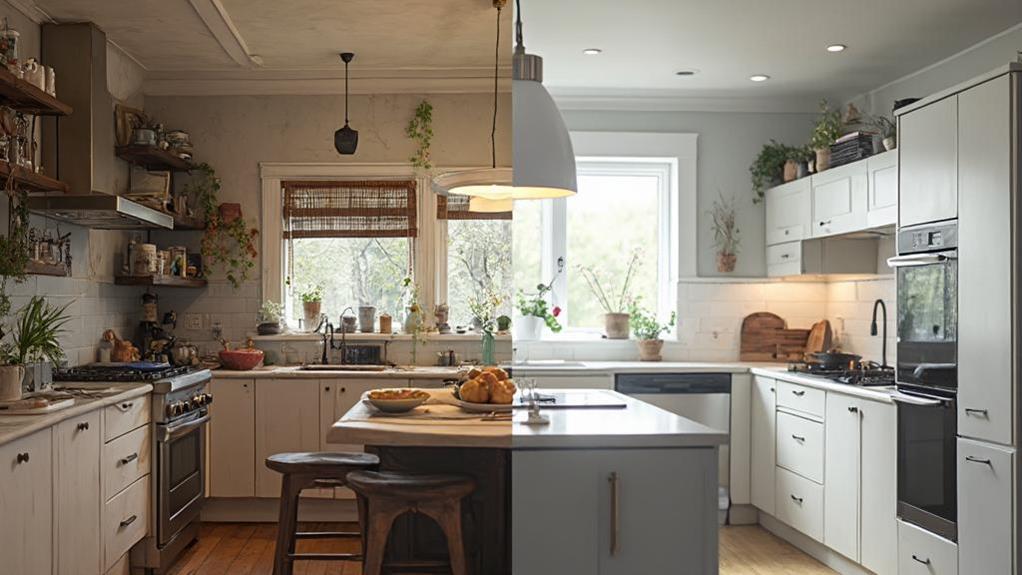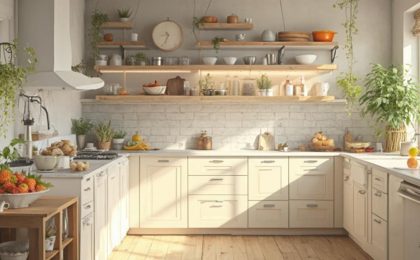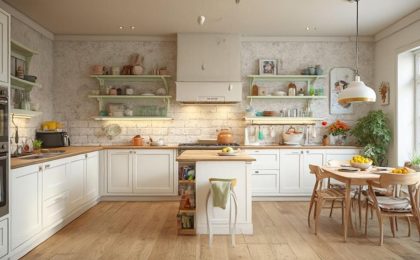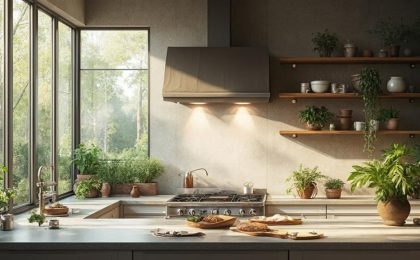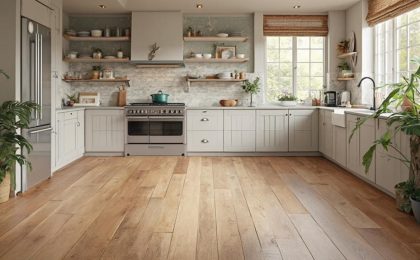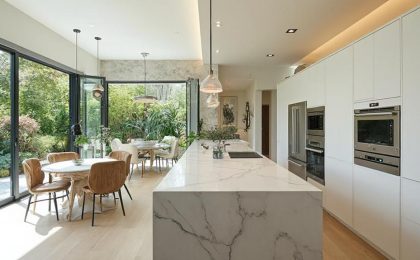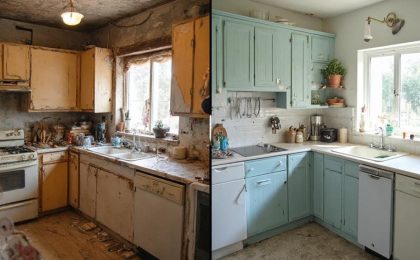When you think about kitchen remodeling, it's easy to fall for common myths that can steer you in the wrong direction. You might assume that a larger kitchen automatically means better functionality or that DIY projects are the most cost-effective approach. But, what if you're overlooking vital factors that can make or break your remodel? Understanding the truth behind these misconceptions is essential for making informed decisions. Let's explore the realities of kitchen remodeling, so you can avoid costly mistakes and achieve the results you really want.
Key insights
- DIY Isn't Always Cheaper: While DIY can save costs, complex tasks often require professional help, making it potentially more expensive in the long run.
- Size Doesn't Determine Functionality: A small, well-designed kitchen can be more functional than a larger one with poor layout and wasted space.
- Trends Fade, Timelessness Lasts: Following kitchen design trends can lead to quick dissatisfaction; focus on timeless elements for enduring appeal and value.
- Aesthetics Shouldn't Overrule Functionality: Prioritizing workflow and storage over purely decorative choices ensures a more practical and usable kitchen space.
- ROI Varies by Renovation Type: Minor updates typically yield higher ROI than major remodels; understanding local market conditions is crucial for renovation decisions.
Kitchen Remodels Are Always Expensive
When considering a kitchen remodel, many homeowners immediately assume it's going to break the bank. However, that's a common myth. You can find budget-friendly options that allow you to transform your space without sacrificing quality. The key is to think creatively and prioritize your needs.
Local bathroom fitters in Bradford can provide valuable insights into cost-effective renovations that suit your style.
Start by exploring cost-effective materials that offer aesthetic appeal without the hefty price tag. For instance, laminate countertops can mimic the look of granite at a fraction of the cost. Additionally, open shelving can replace expensive cabinetry, providing both functionality and a modern touch.
Consider updating your fixtures or hardware instead of a complete overhaul. New cabinet knobs, a stylish faucet, or energy-efficient appliances can make a significant impact without requiring a large investment.
Paint is another powerful tool; a fresh coat can breathe new life into your kitchen at minimal expense.
DIY Is the Best Option
Many homeowners believe that taking the DIY route for kitchen remodeling is the best choice, thinking it'll save money and give them complete control over the project. While DIY can offer cost-effective solutions, it's important to evaluate your skills before diving in.
A thorough skill assessment will help you understand what tasks you can handle and which ones might require professional expertise. Additionally, hiring local kitchen fitters can guarantee compliance with local codes and enhance the overall design of your kitchen.
You might excel in painting or installing fixtures, but complex plumbing or electrical work can lead to costly mistakes if not done correctly. Even seemingly straightforward projects can quickly become overwhelming without proper experience.
Additionally, consider the time commitment involved. DIY projects often take longer than anticipated, disrupting your daily life and kitchen functionality.
While DIY can be a rewarding experience, it's vital to weigh the potential risks against the savings. Sometimes, hiring a professional might be the more prudent choice, assuring quality workmanship and peace of mind.
Ultimately, remember that the goal is to create a functional and beautiful kitchen that meets your needs, so choose the path that aligns best with your skills and resources.
Open Concept Is Always Better
You might think that an open concept kitchen is the ideal choice for any home, but space constraints can quickly change that perception.
If you have a smaller area, an open layout might feel cramped and noisy, reducing your overall comfort.
Additionally, consider whether you value privacy during meal prep or entertaining; sometimes, designated spaces are more beneficial than a completely open design.
For example, having a separate kitchen can allow for more specialized features, such as customized tiling solutions that fit your specific needs, as offered by local tile fitters.
Space Constraints Matter
Open concept kitchens are often hailed as the ultimate design choice, but space constraints can greatly influence whether this layout is truly the best fit for your home. When considering a remodel, you need to evaluate the dimensions and flow of your existing space. An open concept may not be ideal if your kitchen is small or awkwardly shaped.
Space optimization is key in any kitchen design. You should think about how you use your kitchen daily and what layout considerations matter most to you. For instance, if you love to cook, a more traditional layout with defined zones might be more functional than an open space that lacks storage and prep areas.
Moreover, consider how your kitchen interacts with adjacent rooms. If you have limited square footage, creating an open concept might sacrifice valuable storage and counter space, which can lead to a cluttered, inefficient environment.
Prioritize practicality over trends. By understanding your space constraints and how they affect your kitchen's functionality, you can create a design that truly works for you, rather than simply following the latest style fads.
Privacy and Noise Levels
Embracing the allure of an open concept kitchen often overlooks the essential aspects of privacy and noise levels. While these layouts promote social interaction, they can also lead to unwanted distractions and a lack of personal space. You may find that the clattering of dishes or the hum of appliances disrupts your peaceful cooking experience.
To tackle these challenges, consider incorporating soundproofing techniques into your kitchen design. For instance, installing acoustic panels or sound-absorbing materials can greatly reduce noise levels. If you're planning a renovation, think about adding thicker drywall or soundproofing insulation between the kitchen and adjacent living areas.
Moreover, implementing privacy solutions is essential. You might explore options such as sliding barn doors or decorative screens that can provide separation when needed.
Even strategically placed plants or furniture can create a sense of division without completely closing off the space.
Ultimately, balancing the benefits of an open concept with effective noise and privacy solutions will enhance your kitchen's functionality, ensuring it remains a welcoming place for both cooking and conversation.
You Must Follow Trends
You don't need to follow every trend when remodeling your kitchen.
Focusing on timeless design and your personal style will create a space that feels uniquely yours.
Timeless Design Over Trends
Many homeowners believe that following the latest design trends is essential for a successful kitchen remodel, but this approach can often lead to fleeting satisfaction. Instead, focusing on timeless design will provide you with enduring appeal that lasts for years. By incorporating classic elements into your kitchen, you create a space that feels both fresh and familiar.
Consider these comparisons when choosing your design:
| Classic Elements | Trendy Features |
|---|---|
| Natural wood cabinetry | High-gloss finishes |
| Subway tile backsplash | Colorful patterned tiles |
| Farmhouse sinks | Integrated appliance designs |
When you prioritize timeless design, you steer clear of the constant cycle of renovation that comes with chasing trends. Classic elements like durable materials and neutral palettes guarantee your kitchen remains stylish regardless of changing fashions. This approach not only enhances the value of your home but also creates a comfortable atmosphere you'll enjoy for years to come. Remember, it's not about what's in vogue; it's about creating a lasting environment that reflects your taste and lifestyle. So, embrace designs that stand the test of time, and you won't regret it.
Personal Style Matters Most
Personal style plays an essential role in kitchen remodeling, and incorporating current trends can elevate your space in remarkable ways. While it's tempting to think you must follow every trend, the truth is that your personal preferences should guide your design choices. Trends come and go, but your kitchen should reflect your unique aesthetics and lifestyle.
Start by identifying what resonates with you. Whether you love sleek modern lines or cozy rustic elements, let that inform your decisions. For instance, if you're drawn to bold colors or unique textures, don't shy away from integrating them into your design.
Trends can complement your style but should never overshadow it. Consider how incorporating certain trends can enhance your space. For example, open shelving might be trendy, but if it aligns with your personal taste and storage needs, it's a win-win.
Functionality Trumps Aesthetics
Functionality often takes precedence over aesthetics in kitchen remodeling, and it's crucial to recognize that trends can play a significant role in this balance. When planning your kitchen, consider how an efficient layout enhances your kitchen workflow.
Here's a quick comparison of functional versus purely aesthetic elements:
| Functional Elements | Aesthetic Elements |
|---|---|
| Open floor plan | Decorative backsplashes |
| Ample storage solutions | Trendy light fixtures |
| Durable countertops | Unique cabinet designs |
| Accessible appliances | Stylish but impractical decor |
Focusing on functionality doesn't mean ignoring aesthetics; rather, it's about integrating both for a cohesive design. Think about how you move through your space and how various elements can streamline your tasks. Trends in kitchen design, such as minimalist cabinetry or open shelving, can still align with your need for effective storage and workflow. Prioritizing functionality guarantees your kitchen not only looks great but also works efficiently for your everyday needs. Remember, a well-planned kitchen is one that feels good to use, making your investment worthwhile in the long run.
Bigger Is Always Better
A common misconception in kitchen remodeling is that a larger space automatically equals a better kitchen. While it's tempting to think that more square footage means more functionality, the truth lies in the ideal layout and space efficiency. You can have a small kitchen that works flawlessly if you design it thoughtfully.
Consider how you use your kitchen daily. A well-designed smaller kitchen can often provide the same capabilities as a larger one, thanks to clever storage solutions and efficient work zones. By prioritizing an ideal layout, you can create a workflow that minimizes unnecessary movement, making cooking and entertaining a breeze.
Additionally, larger kitchens can lead to wasted space if not planned carefully. Empty corners and underutilized areas can detract from the overall functionality of the kitchen. Instead of focusing solely on size, think about how to maximize your available space.
Incorporate multi-functional furniture, smart storage options, and effective lighting to enhance your kitchen's usability, regardless of its size. Ultimately, a well-designed kitchen—no matter how big or small—can be both beautiful and efficient, making your cooking experience enjoyable and practical.
Renovations Add Immediate Value
Many homeowners believe that kitchen renovations instantly boost a home's market value. While it's true that certain upgrades can enhance resale value, the immediate return on investment may not be as high as you think. Market trends play a significant role in determining how much value your renovation will add.
Before diving into a remodel, consider the following factors:
| Renovation Type | Typical ROI (%) |
|---|---|
| Minor Kitchen Remodel | 80-85% |
| Major Kitchen Remodel | 60-70% |
| Cosmetic Updates | 75-80% |
These percentages vary based on your local real estate market conditions and the quality of the renovations. A minor kitchen remodel often yields the highest return, as it appeals to a broader range of potential buyers. In contrast, a major overhaul might not always recoup your investment, especially if it doesn't align with current market trends.
Ultimately, it's important to assess your goals and the local market before proceeding. Remember, a well-planned kitchen renovation can increase value, but it's not a guaranteed instant payoff.
Frequently Asked Questions
Can I Remodel My Kitchen Without Hiring a Contractor?
Yes, you can remodel your kitchen without hiring a contractor, but it comes with its own remodeling challenges.
You'll need to budget wisely and plan your design carefully. Familiarize yourself with the tool essentials required for the job.
Don't forget to prioritize safety precautions to avoid injuries. With determination and the right resources, you can create a beautiful DIY kitchen that suits your style and meets your needs.
Just be prepared for the work ahead!
What Are the Best Materials for a Budget-Friendly Kitchen Remodel?
When you're looking for budget-friendly materials for your kitchen remodel, consider laminate countertops, vinyl flooring, and stock cabinets.
These options provide durability without breaking the bank.
For cost-saving tips, shop during sales or clearance events, and don't hesitate to explore second-hand stores for unique finds.
How Long Does a Typical Kitchen Remodel Take?
A typical kitchen remodel usually takes between six to twelve weeks, but your timeline can vary based on several factors.
You'll find that renovation phases, like design, demolition, and installation, each require different time commitments. If you're making structural changes or waiting on custom materials, it might take longer.
To stay on track, plan ahead and communicate with your contractor about expectations and potential delays. That way, you'll minimize surprises along the way.
Are There Eco-Friendly Options for Kitchen Renovations?
Absolutely, there are plenty of eco-friendly options for your kitchen renovation.
You can choose sustainable materials like bamboo or reclaimed wood for cabinets and countertops. Incorporating energy-efficient appliances not only reduces your carbon footprint but also lowers utility bills.
Consider installing LED lighting and low-flow faucets to enhance efficiency further.
How Do I Choose the Right Style for My Kitchen Remodel?
Choosing the right style for your kitchen remodel starts with understanding your kitchen aesthetics and how they align with your lifestyle.
Consider a functional layout that enhances workflow, making cooking and entertaining easier.
Look at current design trends and think about colors, materials, and finishes that reflect your personal taste.
Don't forget to prioritize practicality; guarantee the style you select complements the functionality of your space and meets your daily needs.
Summary
In kitchen remodeling, it's essential to separate fact from fiction. While some myths suggest that bigger spaces and trendy designs are inherently better, a well-thought-out plan can deliver fantastic results in any size. Don't rush into DIY projects without considering their complexity, and remember that lasting functionality often trumps fleeting aesthetics. By prioritizing what truly matters, you can create a kitchen that not only meets your needs but also stands the test of time.
